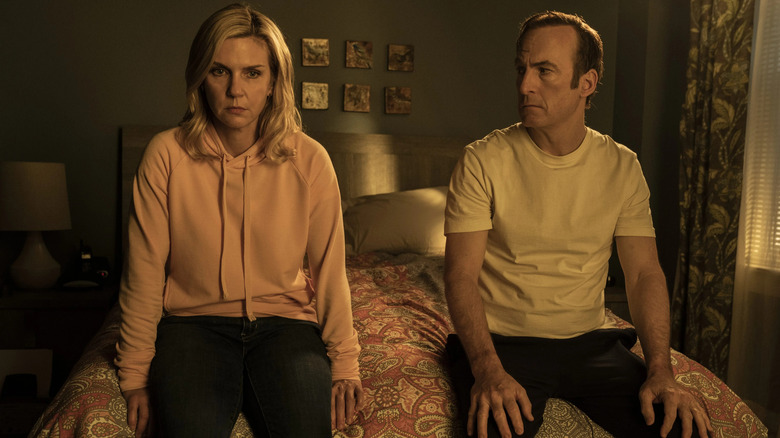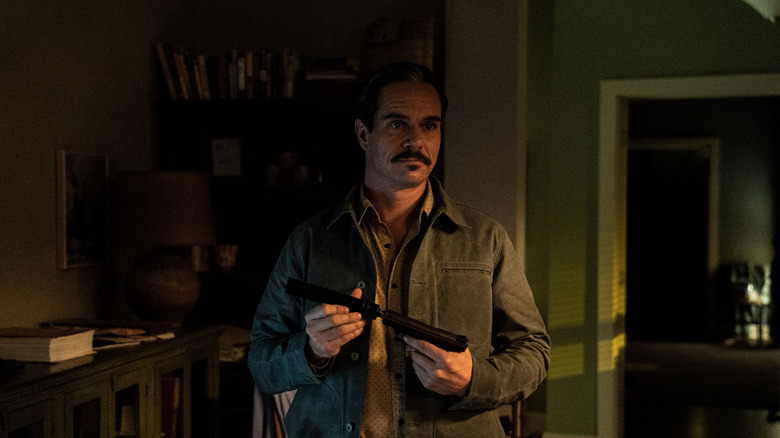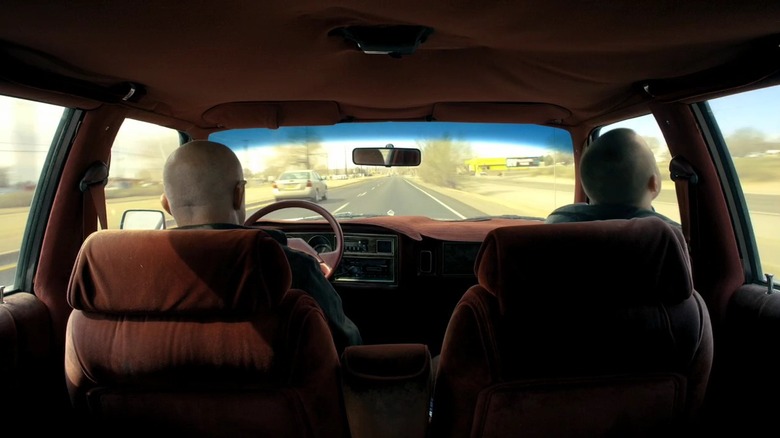Better Call Saul Season 6 Didn't Plot Out When Characters Were Going To Die
Spoilers for "Better Call Saul" follow.
In prequels, foregone conclusions are, well, foregone. The writers crafting the stories and the audiences watching them know ahead of time that the characters have to end in the spot where we first met them in the original story. Likewise, newly introduced characters who weren't in the original have to be taken off the board — sometimes lethally.
"Better Call Saul" acknowledges this from the beginning. The very first scene of the series actually takes place after "Breaking Bad" — former criminal lawyer Saul Goodman (Bob Odenkirk) is in hiding, living as Omaha Cinnabon manager Gene Takovic. As I've written before, the show comes with the built-in tragedy that "Slippin' Jimmy" McGill, a plucky lawyer trying to go straight, will one day become the consigliere of Walter "Heisenberg" White (Bryan Cranston).
There are five major characters in "Better Call Saul" who were nowhere to be seen in "Breaking Bad:" Kim Wexler (Rhea Seehorn), Chuck McGill (Michael McKean), "Nacho" Vargas (Michael Mando), Howard Hamlin (Patrick Fabian), and Lalo Salamanca (Tony Dalton). Going into the sixth and final season, all but one of them — RIP Chuck — were still alive.
In a July 2022 interview with The Hollywood Reporter, series co-creator Peter Gould discussed the writing process for season 6. While the new characters (barring Kim) do die during the season, Gould says he and his team didn't approach writing as a series of checkpoints they had to hit.
Back-to-back deaths
Howard and Lalo meet their ends in back-to-back episodes. The mid-season finale, "Plan and Execution," ends with Lalo showing up at Jimmy and Kim's apartment and then blowing Howard's brains out. The following episode, "Point and Shoot," features Lalo dying at the hands of Gus Fring (Giancarlo Esposito) after initially getting the drop on the chicken man.
"Better Call Saul" has always felt like two shows in one — the legal dramedy of Jimmy McGill on one hand, and the hardboiled crime drama of Mike Erhmantraut (Jonathan Banks) on the other. The show's marketing even reflects this divide, a divide that escalated in season 3 with the introduction of Gus Fring (Giancarlo Esposito) into Mike's half of the story.
Lalo was the only supporting character who crossed over — he was Gus' rival, but Jimmy was roped into representing him during season 5. His murdering Howard, the character most removed from the cartel, was the most shocking sign of the show's two worlds colliding.
At the time, everyone was surprised the show seemed to be climaxing with five episodes left to go. And that's because the final episodes of "Better Call Saul" transitioned to a full-on sequel. THR asked Peter Gould about how Lalo and Howard's deaths came early. While Gould had to be vague about this, he explained he and his writers preferred to let things "organically fall."
"It's not something that we necessarily plotted out on a board and said, 'This is the episode to do this,' and 'This is the episode to do that,' but our main focus is really on the development and the psychology of the characters."
Steering the show correctly
"Breaking Bad" creator Vince Gilligan managed his writers' room in much the same way Peter Gould ran the "Better Call Saul" one. Interviewed in September 2013 for The Guardian, Gilligan said, "The worst thing the French ever gave us is the auteur theory," and described a collaborative atmosphere where he and his writers were always asking two questions: "'Where's a character's head at?' and 'What happens next?'"
An example cited in the piece is season 4 episode 5, "Shotgun." Unlike Gould and co., Gilligan and the "Breaking Bad" writers apparently did use the "mapping the board" type of planning, but were vague enough to give themselves leeway. (The index card for the finale just said, "Boom.") The card representing season 4 episode 5 was blank, so the writers hunkered down and asked themselves where the characters were at. That's how the episode ended up being about Mike taking Jesse (Aaron Paul) under his wing at Gus' behest. Gilligan explained to The Guardian:
"If Walt is dead, Gus has nothing, because Jesse can't cook like Walt. If Jesse's dead, Walt goes berserk and doesn't cook and Gus has nothing. But if he keeps Jesse alive and yet divides Jesse's loyalties in his Machiavellian fashion, then he's really accomplished something."
This is a perfect example of "focus [...] on the development and the psychology of the characters" that Gould cites. When THR asked just how "organic" the creation of a perfect midpoint, bookended by character deaths, was, Gould acknowledged, "We knew we needed quite a bit of runway to take the plane off again."
If you're too freewheeling a writer, you can leave your story without the needed structure. However, what the writers of "Breaking Bad" and "Better Call Saul" understood is that structure should guide writers, not constrain them.


